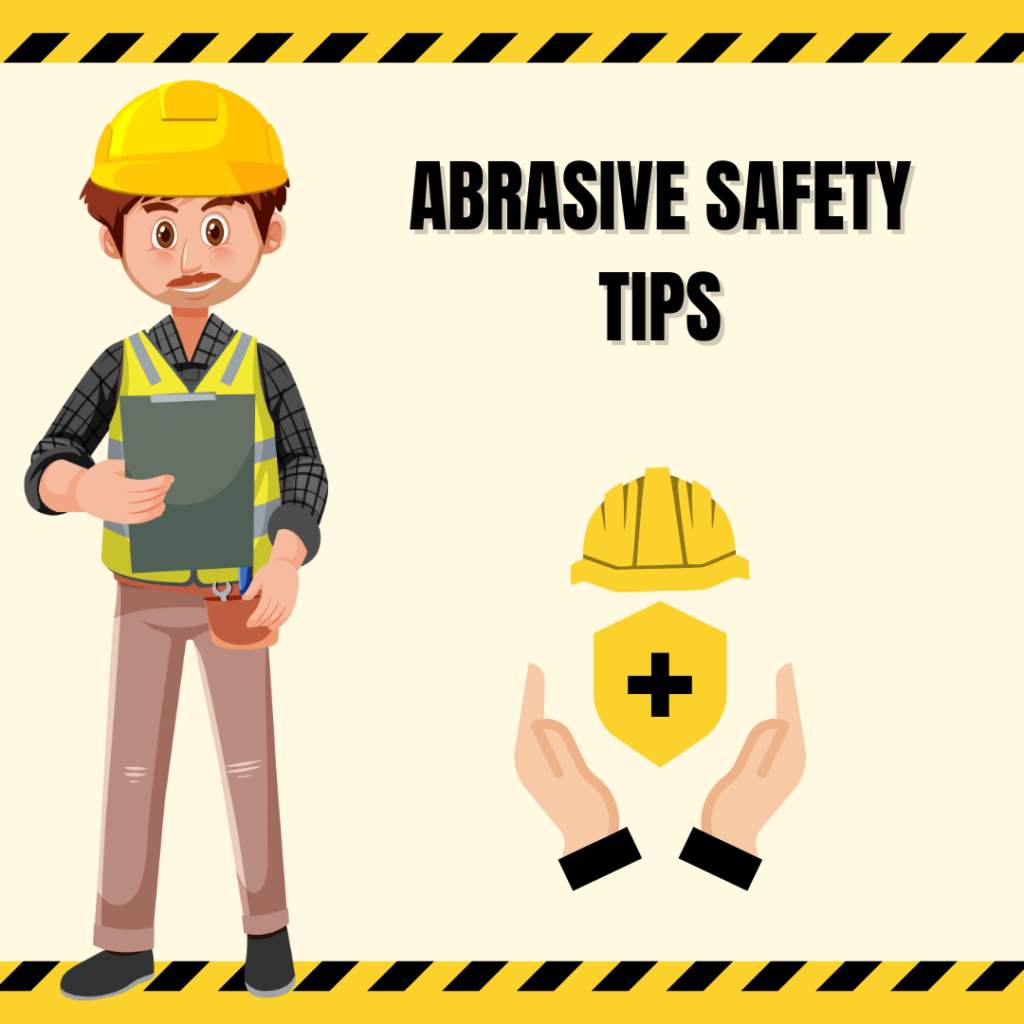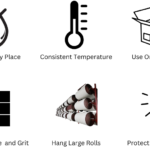
Abrasives are indispensable tools in many industries, from metalworking and woodworking to automotive repair and construction. However, the power and effectiveness of abrasives come with potential risks if not handled properly. Ensuring safety while using abrasives is critical to protecting yourself and others in the workspace. In this comprehensive guide, we will cover essential abrasive safety tips, including how to use abrasives safely, key precautions to take, and best practices to follow. By adhering to these guidelines, you can minimize risks and maintain a safe working environment.
Understanding the Risks of Abrasive Tools
Before diving into the safety tips, it’s important to understand the potential hazards associated with abrasive tools. These hazards include:
- Physical Injuries: Abrasives can cause cuts, abrasions, and punctures if they come into direct contact with the skin. Improper use or handling can lead to serious injuries.
- Respiratory Issues: The dust and particles generated by abrasive processes can be harmful if inhaled, leading to respiratory problems, including lung irritation and long-term health issues.
- Eye Injuries: Flying debris and dust can cause serious eye injuries if proper eye protection is not worn.
- Hearing Damage: The noise generated by abrasive tools, especially power tools, can lead to hearing loss over time if adequate hearing protection is not used.
- Fire Hazards: Sparks generated by abrasive tools, particularly when working with metals, can ignite flammable materials in the vicinity, posing a fire risk.
Essential Abrasive Safety Tips
To minimize the risks associated with abrasives, it’s crucial to follow these safety tips:
1. Wear Appropriate Personal Protective Equipment (PPE)
One of the most important aspects of abrasive safety is wearing the right personal protective equipment (PPE). The essential PPE for using abrasives includes:
- Safety Glasses or Goggles: Protect your eyes from flying debris and dust. In environments with a high risk of particle exposure, consider using full-face shields.
- Respiratory Protection: Depending on the material being worked on, a dust mask or respirator may be necessary to prevent inhalation of harmful particles.
- Gloves: Wear sturdy gloves to protect your hands from cuts and abrasions.
- Hearing Protection: Use earplugs or earmuffs to protect your hearing when operating noisy abrasive tools.
- Protective Clothing: Wear long sleeves, pants, and sturdy footwear to protect your skin from flying particles and potential injuries.
2. Inspect Abrasives Before Use
Before using any abrasive tool, it is critical to inspect it thoroughly. Check for any signs of damage, such as cracks, tears, or wear that could compromise the integrity of the abrasive. Using a damaged abrasive can lead to dangerous situations, including tool failure and injury.
3. Follow Manufacturer’s Instructions
Always follow the manufacturer’s instructions for the proper use, maintenance, and storage of abrasives. This includes adhering to recommended operating speeds, pressure, and usage guidelines. Misusing abrasives by exceeding their designed parameters can lead to accidents.
4. Secure the Workpiece Properly
Before beginning any abrasive task, ensure that the workpiece is securely fastened or clamped in place. A loose or unstable workpiece can move unexpectedly, leading to loss of control and potential injury.
5. Use the Right Abrasive for the Job
Using the correct abrasive for the material and task at hand is essential for both safety and effectiveness. Different materials require different types of abrasives, and using the wrong one can result in poor performance and increased risk of accidents.
6. Avoid Overloading or Forcing the Abrasive
Do not overload the abrasive tool or force it beyond its capacity. Overloading can cause the tool to overheat, break, or lose control, leading to potential injuries. Apply consistent, moderate pressure to let the abrasive do its work efficiently.
7. Maintain a Clean and Organized Work Area
A clean and organized work area is crucial for safety. Keep the workspace free of clutter, debris, and flammable materials that could pose a fire hazard. Ensure that the floor is free of trip hazards, and that tools are stored properly when not in use.
8. Ensure Adequate Ventilation
Abrasive processes can generate a significant amount of dust and fumes, which can be harmful if inhaled. Work in a well-ventilated area or use local exhaust ventilation systems to remove dust and fumes from the workspace.
9. Be Aware of Your Surroundings
Always be aware of your surroundings when using abrasives. Ensure that others in the area are at a safe distance and that they are also protected from potential hazards. Communicate clearly with coworkers and be mindful of any changes in the environment that could affect safety.
10. Never Bypass Safety Guards
Safety guards are designed to protect you from moving parts and flying debris. Never bypass or remove safety guards from abrasive tools. Ensure that all guards are in place and functioning correctly before starting work.
11. Turn Off Tools When Not in Use
When you are finished using an abrasive tool, turn it off and unplug it or disconnect the power source. This prevents accidental startups and reduces the risk of injury when the tool is not in use.
Specific Safety Tips for Different Types of Abrasives
Different types of abrasives come with specific safety considerations. Here are some tips for safely using common types of abrasives:
1. Sandpaper
- Use a Sanding Block or Holder: When using sandpaper by hand, use a sanding block or holder to maintain even pressure and prevent finger injuries.
- Avoid Inhaling Dust: Sanding can create fine dust particles that are harmful if inhaled. Always wear a dust mask or respirator and ensure proper ventilation.
- Dispose of Used Sandpaper Properly: Used sandpaper can become clogged with material and lose its effectiveness. Dispose of it properly to avoid confusion with new sandpaper.
2. Grinding Wheels
- Check for Cracks: Inspect grinding wheels for cracks or defects before use. A cracked wheel can shatter during operation, posing a serious risk.
- Use a Wheel Guard: Always use a wheel guard when operating a grinder to protect yourself from flying fragments.
- Stand to the Side: When starting a grinder, stand to the side, not directly in front of the wheel. This minimizes the risk of injury if the wheel fails.
3. Cutting Discs
- Secure the Workpiece: Ensure that the workpiece is firmly secured before using a cutting disc. A loose workpiece can cause the disc to bind and kick back.
- Use Light Pressure: Apply light, consistent pressure when using a cutting disc. Forcing the disc can cause it to overheat and fail.
- Wear a Face Shield: In addition to safety glasses, consider wearing a face shield to protect your entire face from sparks and debris.
4. Wire Brushes
- Inspect for Broken Wires: Check wire brushes for broken or loose wires before use. Broken wires can become projectiles and cause injury.
- Wear Gloves and Long Sleeves: Wire brushes can shed wires during use, which can puncture the skin. Wearing gloves and long sleeves provides added protection.
- Avoid Contact with Skin: Do not allow the wire brush to come into direct contact with your skin. The wires can cause severe abrasions or punctures.
Emergency Preparedness and Response
Despite taking all precautions, accidents can still happen. Being prepared to respond to an emergency is a crucial aspect of abrasive safety.
1. Know First Aid Procedures
Familiarize yourself with basic first aid procedures for common injuries associated with abrasives, such as cuts, burns, and eye injuries. Keep a well-stocked first aid kit in the work area and ensure that everyone knows where it is located.
2. Fire Safety
Keep a fire extinguisher nearby when working with abrasives, especially when grinding or cutting metal. Ensure that the extinguisher is rated for the types of fires that could occur in your workspace. In case of a fire, know the evacuation routes and emergency procedures.
3. Eye Injury Response
If debris or particles enter the eye, do not rub it. Use an eye wash station to flush the eye thoroughly with water and seek medical attention if necessary. It’s important to act quickly to prevent further damage to the eye.
4. Emergency Shutdown Procedures
Know how to quickly and safely shut down abrasive tools in case of an emergency. This includes knowing where the power switches are located and how to disconnect power sources.
How Sandpaper Rodiez Ensures Safety and Quality
At M/s Sandpaper Rodiez, we prioritize both the quality and safety of our products. We source the highest quality abrasives from around the world and customize them to meet our clients’ specific needs. Our abrasives are designed to perform reliably and safely, ensuring that you can work with confidence.
We also provide detailed safety guidelines and support to our clients, helping them to use our abrasives safely and effectively. Whether you’re a professional contractor or a DIY enthusiast, our team is here to assist you with the right products and safety advice.
Conclusion
Using abrasives safely is not just about protecting yourself but also about ensuring the quality of your work. By following the safety tips outlined in this guide, you can reduce the risks associated with abrasive tools and create a safer, more productive work environment.
Remember to always wear the appropriate PPE, inspect your tools before use, and follow the manufacturer’s guidelines. At Sandpaper Rodiez, we are committed to providing top-quality abrasives and expert



